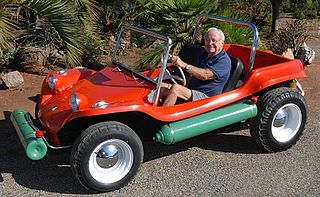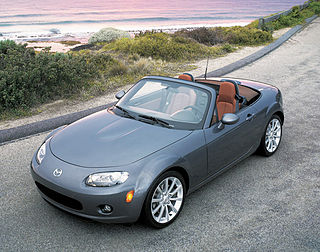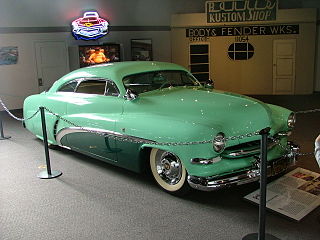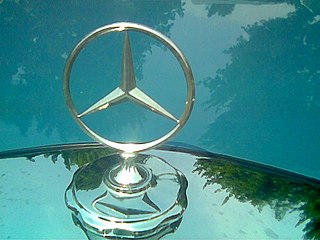
A dune buggy — also known as a beach buggy — is a recreational off-road vehicle with large wheels, and wide tires, designed for use on sand dunes, beaches, off-road or desert recreation. The design is usually a topless vehicle with a rear-mounted engine. A dune buggy can be created by modifying an existing vehicle or custom-building a new vehicle.

A convertible or cabriolet is a passenger car that can be driven with or without a roof in place. The methods of retracting and storing the roof vary among eras and manufacturers.
Automotive aerodynamics is the study of the aerodynamics of road vehicles. Its main goals are reducing drag and wind noise, minimizing noise emission, and preventing undesired lift forces and other causes of aerodynamic instability at high speeds. Air is also considered a fluid in this case. For some classes of racing vehicles, it may also be important to produce downforce to improve traction and thus cornering abilities.

Nash Motors Company was an American automobile manufacturer based in Kenosha, Wisconsin from 1916 until 1937. From 1937 through 1954, Nash Motors was the automotive division of the Nash-Kelvinator Corporation. As sales of smaller firms declined after 1950 in the wake of the domestic Big Three automakers’ advantages in production, distribution, and revenue, Nash merged with Hudson Motors to form American Motors Corporation (AMC). Nash automobile production continued from 1954 through 1957 under AMC.

A hubcap or hub cap is a decorative disk on an automobile wheel that covers at minimum the central portion of the wheel, called the hub. An automobile hubcap is used to cover the wheel hub and the wheel fasteners to reduce the accumulation of dirt and moisture. It also has the function of decorating the car.
A classic car is typically an automobile 25 years or older; however, definitions vary. A common theme is that of an older car of historical interest is collectible and tends to be restored rather than scrapped, though sometimes age is not a factor. Classic cars are often considered a subset of a broader category of "collector cars," including restored classic cars and newer exotic vehicles. A subset of classic cars are known as antique cars, manufactured before 1980, or vintage cars, manufactured before World War II.

Mopar is the parts, service, and customer care division of the former Chrysler Corporation, now owned by Netherlands-based automobile manufacturer Stellantis. It serves as a primary OEM accessory seller for Stellantis brands under the Mopar brand. The name is a portmanteau of the words "MOtor" and "PARts". "Mopar" is also used as a nickname by enthusiasts of Chrysler-built products to refer to any product built by the company.

A dashboard is a control panel set within the central console of a vehicle or cockpit of an aircraft or spacecraft. Usually located directly ahead of the driver, it displays instrumentation and controls for the vehicle's operation. An electronic equivalent may be called an electronic instrument cluster, digital instrument panel, digital dash, digital speedometer or digital instrument cluster.
The Landau began as a carriage design with a folding fabric top consisting of two sections supported by external elliptical springs. This landau roof design was adopted in early automobiles as a convertible top. The term, however, came to mean a simulated convertible. A landau bar is an ornamental feature located on a car's c-pillar derived from the roof form, primarily used on hearses.

A hardtop is a rigid form of automobile roof, typically metal, and integral to the vehicle's design, strength, and style.

In automotive engineering, a grille covers an opening in the body of a vehicle to allow air to enter or exit. Most vehicles feature a grille at the front of the vehicle to protect the radiator and engine. Merriam-Webster describes grilles as "a grating forming a barrier or screen; especially: an ornamental one at the front end of an automobile." The word 'grille' is commonly misspelled as 'grill' which instead refers to the cooking method. Other common grille locations include below the front bumper, in front of the wheels, in the cowl for cabin ventilation, or on the rear deck lid. Grilles evolved from previously installed gravel shields that were designed to protect exposed radiators typically used on cars until the early 1930s.

A custom car is a passenger vehicle that has been altered to either improve its performance, change its aesthetics, or a combination of both. Some automotive enthusiasts in the United States want to push "styling and performance a step beyond the showroom floor - to truly craft an automobile of one's own." A custom car in British according to Collins English Dictionary is built to the buyer's own specifications.

A hood ornament, also called a motor mascot or car mascot, is a specially crafted model that symbolizes a car company, like a badge, located on the front center portion of the hood. It has been used as an adornment nearly since the inception of automobiles.

Richard Arthur "Dick" Teague was an American industrial designer in the North American automotive industry. He held automotive design positions at General Motors, Packard, and Chrysler before becoming Vice President of Design for American Motors Corporation (AMC), and designed several notable show cars and production vehicles, including AMC's Pacer, Gremlin, and Hornet models, as well as the Jeep Cherokee XJ and either designed or assisted in the designing of later cars for Chrysler such as the Jeep Grand Cherokee and Neon after American Motors' buyout.
The spinner on automobile wheels historically refers to knock-off hub nuts or center caps. They may be the actual, or intended to simulate, the design used on antique vehicles or vintage sports cars. A "spinner wheel" in contemporary usage is a type of hubcap or inner wheel ornament, that spins independently inside of a wheel itself when the vehicle is in motion and continues to spin once the vehicle has come to a stop.

The pillars on a car with permanent roof body style are the vertical or nearly vertical supports of its window area or greenhouse—designated respectively as the A, B, C and D-pillar, moving from front to rear, in profile view.

The Nash Ambassador is a luxury automobile that was produced by Nash Motors from 1927 until 1957. For the first five years it was a top trim level, then from 1932 on a standalone model. Ambassadors were lavishly equipped and beautifully constructed, earning them the nickname "the Kenosha Duesenberg".

The Rambler Six and the Rambler V8 are intermediate sized automobiles that were built and marketed by American Motors Corporation (AMC) for model years 1956 through 1960.

A continental tire or a continental kit is a term used in the United States for an upright externally-mounted spare tire located behind an automobile's trunk, made popular by the Continental Mark Series, which carried a simulated continental tire until 1998.
Car hydraulics are equipment installed in an automobile that allows for a dynamic adjustment in height of the vehicle. These suspension modifications are often placed in a lowrider, i.e., a vehicle modified to lower its ground clearance below that of its original design. With these modifications, the body of the car can be raised by remote control. The amount and kind of hydraulic pumps being used and the different specifications of the subject vehicle will affect the impact of such systems on the height and orientation of the vehicle. With sufficient pumps, an automobile can jump and hop upwards of six feet off the ground. Enthusiasts hold car jumping contests nationwide, which are judged on how high an automobile is able to bounce.















